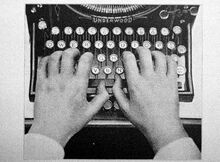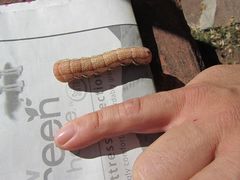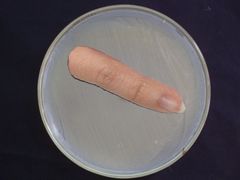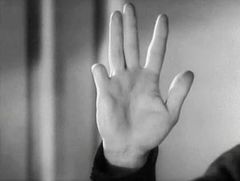Pinky
The pinky, Pestilentia horribilis, is a species of parasitic worm that preys primarily on human hands. A close relative of nematodes, and the thumb, pinkies have been parasitizing humans for thousands of years. Early cave paintings demonstrate the presence of infected hands as early as 40,000 B.C.
Anatomy[edit | edit source]
The pinky is considered by biologists to be one of the most spectacular mimics in the animal kingdom. It is the only species that can fool its host into believing that the parasite is an actual part of its body, much like a government can fool its host into believing that it is an actual part of the country.
An adult pinky has two basic, identifiable parts: the "head," located at the base of the pinky, contains a mouth full of hooklike teeth that anchors the pinky to its host hand. Around the mouth is a hood that attaches to the skin at the edge of the hand. The hood contains nerve endings that detect and mimick signals sent to adjacent fingers. The "tail" is distinguished by a hard growth, the vestigal remains of a deadly stinger.
A second species of pinky has recently been identified favoring infection of the human foot. Little is known about this type, dubbed "pinky toes," and it is advised that sufferers just pretend that it is not there.
Life cycle[edit | edit source]
A mature adult pinky absorbs blood from its host to produces thousands of microscopic eggs an hour, which are constantly distributed throughout the blood system. However, pinky eggs only hatch once they latch onto a hand of a foetus near the end of the first trimester. Once attached, the larva secretes an acidic substance to fuse itself to the foetus and prevents other eggs from attaching. The pinky then continues to grow by absorbing nutrition from the foetus.
Although capable of reproducing asexually, pinkies mate through a human ritual known as a "pinky promise." The ritual involves two infected hosts touching their parasites, upon which the nematodes wrap around each other and secrete low amounts of a moisture containing millions of gametes. Resulting offspring usually contain a few characteristics from every pinkie ever mated with.
Upon death of its host, a pinky will detach itself and shed its camouflage, becoming an earthworm in 2-3 days.
Epidemiology[edit | edit source]
The pinky may be the most successful human parasite ever discovered, having infected virtually all of the human population. Rarely, a few uninfected individuals are born with just the natural four fingers. It is unknown how this occurs.
Treatment[edit | edit source]
Currently, the only known treatment of a pinky infection is surgical removal of the entire pinky. This procedure is rarely done due to its expense and risk of complications, and the fact that it still leaves billions of eggs floating in the body. The World Health Organization has deemed the effect of mild anaemia to be an acceptable outcome over surgery in a press release ("Fuck it, it's too widespread to deal with"(WHO, 1998)).
Awareness[edit | edit source]
For decades, the American Pinky Foundation has spearheaded a campaign decrying the apparent lack of panic surrounding the infestation of nearly every hand in the entire human race. Citing numerous supposed "detrimental effects" to human health caused by pinkies, the APF has declared April 14 as Pinky Awareness Day, encouraging celebration with pinkie-themed cakes, balloons, crafts, and an annual Petite Pinky Pagent. The APF website contains instructions on how to remove one's pinky with only a towel, a rubber band, and a sharp steak knife.
In human culture[edit | edit source]

Pinkies have been ingrained in humans to the extent that the rare uninfected individuals may find it difficult using tools that accommodate the presence of the parasite.
The Japanese Yakuza developed a tradition of removing the parasites from the hands of its members, believing it to strengthen the body.
Most animated cartoon characters are instinctively drawn without pinkies. It is speculated that even after thousands of years of continuous leeching, humans still retain a desire to be free of parasites.




